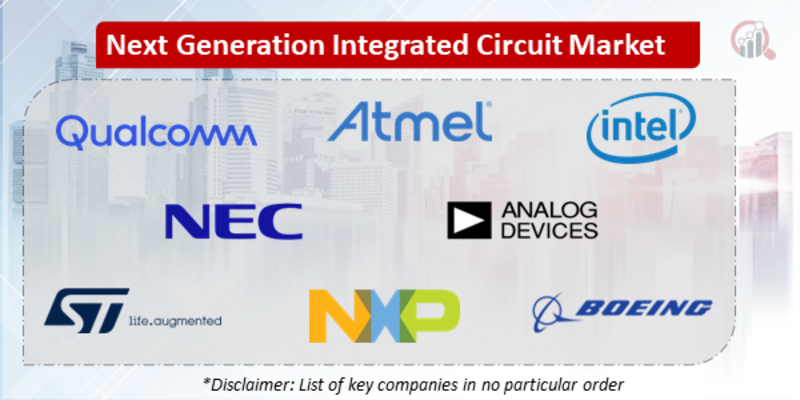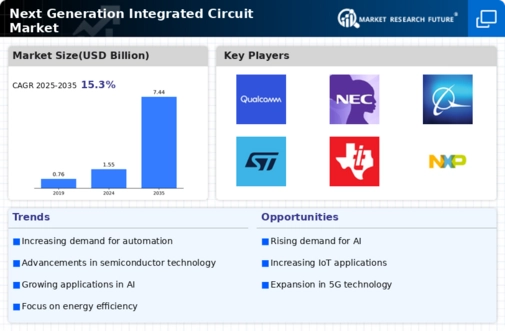Top Industry Leaders in the Next Generation Integrated Circuit Market

The Competitive Landscape in the Next Generation Integrated Circuit Market
The next generation integrated circuit (IC) market hums with the dynamic melody of innovation. These miniature marvels, packed with ever-increasing transistor counts and functionalities, orchestrate the digital symphonies of modern devices, from smartphones to artificial intelligence (AI) systems. Understanding this complex market, where giants clash and startups whisper revolutionary tunes, requires a clear grasp of the competitive landscape, the strategies of key players, and the factors shaping its future rhythms.
Key Player:
- Qualcomm
- Atmel Corporation
- Intel Corporation
- NEC Corporation
- Analog Devices
- Micross Components Inc
- Boeing
- STMicroelectronics
- Texas Instruments
- NXP Semiconductor
Strategies Adopted by Leaders:
- Technological Prowess: Samsung Electronics and TSMC reign supreme with advanced chip fabrication processes and high-performance architectures, setting the benchmark for miniaturization and speed.
- Vertical Specialization: Qualcomm focuses on mobile processors with cutting-edge 5G capabilities, while Broadcom Inc. caters to data center applications with high-bandwidth networking chips.
- Partnership Play: Intel collaborates with universities and research institutions to explore novel materials and device architectures, fostering co-development and staying ahead of the curve.
- Open-Source Platforms: RISC-V International promotes open-source processor designs, lowering entry barriers and accelerating innovation for newcomers.
- Cost Competitiveness: MediaTek prioritizes affordability and offers entry-level processors for budget-conscious devices, catering to price-sensitive segments, particularly in emerging markets.
Factors for Market Share Analysis:
- Technology Leadership: Companies offering superior processing power, lower power consumption, and smaller chip size command premium prices and secure market share by enabling faster, more efficient, and compact devices.
- Application Specificity: Tailoring ICs to specific applications, like high-performance computing in data centers or low-power sensors for IoT devices, is crucial for market penetration.
- Integration and Interoperability: Seamless integration with existing components and compatibility with diverse software platforms are essential for widespread adoption.
- Intellectual Property Landscape: Secure patent portfolios and navigating complex IP rights are crucial for protecting technological advancements and market share.
- Environmental and Sustainability Focus: Developing energy-efficient chips and adhering to green manufacturing practices aligns with the growing focus on sustainability in the tech industry.
New and Emerging Companies:
- Startups like SiFive and Esperanto Technologies: These innovators focus on niche applications like high-performance computing and edge AI, pushing the boundaries of processing power and customization.
- Academia and Research Labs: MIT's Research Laboratory of Electronics and Stanford University's Nanoelectronics Laboratory explore novel materials, 3D chip architectures, and neuromorphic computing, shaping the future of IC technology.
- Emerging Materials Players: Companies like Graphene Flagship and Nanoworld develop advanced materials for transistors and interconnects, influencing core technologies and performance in the market.
Industry Developments:
Qualcomm:
- November 2023, Unveiled its latest Snapdragon processor with integrated 5G modem and enhanced AI capabilities, targeting high-performance smartphones and edge computing applications.
- July 2023, Update: Announced collaboration with a leading university to research next-generation chip architectures for advanced AI workloads.
Atmel Corporation:
- December 2023, Introduced a new family of low-power microcontrollers with built-in security features for secure IoT devices and wearables.
- August 2023, Acquired a startup specializing in edge AI technologies, strengthening its offerings for intelligent IoT devices.








